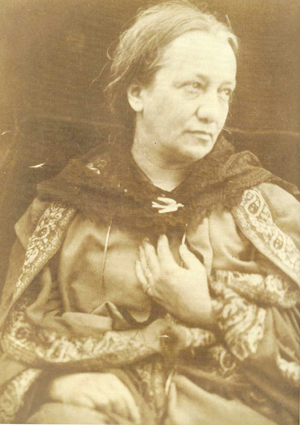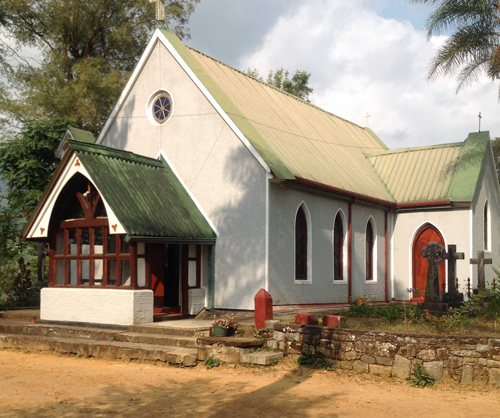Lower Glencairn: Another historic edifice bites the dust

No more: Lower Glencairn the house the Camerons lived in
Julia Margaret Cameron’s last word was “beautiful” as she gazed out from her bedroom window in the Lower Glencairn bungalow, according to her son Henry Cameron who was at her bedside.
The house, subsequently owned by the Bank of Ceylon, bordering Dickoya town on the Glencairn Estate was demolished last month.
Julia Margaret Cameron who died on January 26, 1879 aged 69, was one of the great pictorial photographers of the 19th century. Being a woman, her success was all the more remarkable. She took to photography in the 1850s and in 1864 her daughter also named Julia gifted her with a camera, remarking “It may amuse you to photograph and while away your time and in your solitude at Freshwater.”
The medium was at a nascent stage and largely dominated by men. Wet collodion photography was complex, messy and required skill. The manipulation of a brass bound wooden camera on an unwieldy timber tripod was a challenge. By Victorian standards it was unbecoming for a middle-class woman to engage in such drudgery that stained your fingers.

Julia Margaret Cameron: Portrait by her son Henry
Through trial and error despite the prejudices and discouraging reviews of her male counterparts she soldiered on.
To her advantage throughout her career she had the advice and support of Sir John Herschel, the Astronomer Royal who pioneered the development of photography in the 19th century.
Lacking facilities, she improvised, making her coal shed into a dark room and her living room her studio. Her cameras were very primitive, equipped with a large glass lens with a single focal length– the sitter had to be as close as six feet-eight feet to achieve a full framed image.
She chose to ignore the type of equipment common to professional studios such as head supports and screens, much to the discomfiture of her sitters who had to endure 8-10 minutes long poses without shifting their head or body as any movement would register as a blur.
Many of her images were fuzzy and slightly out of focus – that she claimed was intentional and became a hallmark of her photography. It produced a dramatic arresting softness to many of her portraits and ‘what after all is good focus?’ she is reputed to have said. Although some derided her technique as being sloppy, she rose to emerge as one of the greatest portraitists of her time
During the first few years of her practice she had exposed as many as 500 plates and produced some of the finest portraits of her career “of famous men and fair women”- eminent men and women of the artistic and scientific world such as Watts, Rossetti, Thackeray, Longfellow, Herschel, Darwin and others who came to pay homage to her immediate neighbour, the poet Laureate Alfred Lord Tennyson. The unsuspecting visitor was propelled into her living room and would be coerced into sitting for a portrait – a tortuously long exercise.
The majority of her prints were bound into albums and presented to her close friends and collaborators and when she couldn’t make ends meet, she would often exhibit and market her prints at Colnaghis, a London gallery renowned for the works of Old Masters.
Her well-known husband, the scholarly aesthete Charles Hay Cameron was 20 years her senior. They married in British India’s capital, Calcutta in 1838. An influential and powerful figure in the 19th century he succeeded Thomas Macaulay in the Supreme Council.
He was appointed by the Government in London to formulate and report on the judicial and civil administration of the colony and was offered the post of Governor but turned it down.
On March 26, 1830, Charles Cameron arrived at Galle on the Sesstoris to serve on the commission and after 11 months, on February 21, 1831, returned to England on the Athertoll. But he was besotted with the idea of living in Ceylon. “I have long contemplated Ceylon as my final resting place and fixed the site of my tomb,” he said. The reference was probably to St. Mary’s Church Bogawantalawa, 16 miles from Glencairn where he lies buried.
Following the loss of her daughter who died at childbirth in 1873, and the long absence of her family – husband and four sons settled in Ceylon, the fifth serving in the army in Egypt, Julia with her husband and son Hardinge decided to leave England for Ceylon in October 1875.
After sailing to Galle, the couple moved into their son (he was Governor Gregory’s Private Secretary and Assistant Government Agent) Herschel Henry Cameron’s coastal residence.
Julia set to work and produced several close studies of the local workers and peasants of her son’s estate in Kalutara. Contrary to all that has been written – she was as busy at her photographic work as in England. The botanical painter Marianne North who made two visits and resided with the Camerons in Kalutara in 1877 captured her frenetic efforts to improve her portraiture work in her diary entries in great detail.
Julia’s photographic efforts, she recorded, were everywhere -covering every inch of the walls, floors, settees, tables, chairs.
Of her artist friend North, she made several portrait studies though only four have survived.
In May 1878 both Julia and Charles Cameron returned to England with their son Hardinge to address medical issues as Charles was now nearing 80 and also to attend family reunions

St Mary’s Church: The last historical link with the Camerons
As for Julia’s health, the family felt it was better if she moved to the cooler climate of the hills surrounding Glencairn estate.
During her last few days she had the comfort of having her family around her including Charles and her four sons – Ewen, the planter who managed his father’s estates, Hardinge attached to the Civil Service, Henry who was temporarily attending to family affairs and Charles back from Cambridge. In her last journey to St. Mary’s churchyard, her coffin was drawn by a carriage of six white Brahmin bulls accompanied by Charles and her four sons.
Charles died two years later at Nuwara Eliya and the cortege accompanied by his two sons on horseback through pelting monsoonal rain arrived at Glencairn. The next day, the cortege went to St. Mary’s Church where both Julia and Charles are buried side by side.
Julia Margaret Cameron and her husband’s lengthy obituaries were published both in the local newspapers as well as the Times in England. Until recently they remained the only husband and wife couple to have both their names included in the prestigious Dictionary of National Biography.
Unfortunately, buildings linking the Camerons with Ceylon are extinct. Only the bungalow at Rahatungodde, Upper Hewaheta – Charles Cameron’s favoured residence, (a 2000 acre property when he first purchased the forest land) remains but is at present altered beyond recognition.
In 1990 on a visit to St. Mary’s Church Bogawantalawa I was saddened to see the parlous state of the building. On my return I relayed the report to the Julia Margaret Cameron Trust, Isle of Wight, on which I assisted the Committee on matters concerning the Camerons.
Among those kindred spirits Sir Christopher Ondaatje undertook to fund a project for both restoring the church and building residential quarters for the parish priest.
But on my next visit, I found the parish priest’s quarters abutting the church and the eaves had damaged one of the eight stained-glass windows. The stained-glass windows were manufactured by Lavers, Barraud and Westlake who delivered them in 1877. Lavers, Barraud and Westlake, an English firm that produced these stained-glass windows from 1844-1921, were an important part of the Gothic revival movement that impacted English church architecture in the 19th century.
Now that Lower Glencairn where Julia Margaret Cameron lived is gone, it is imperative that the Anglican Church moves fast to save this last link with the Camerons. The history and beauty of this church demand attention.



